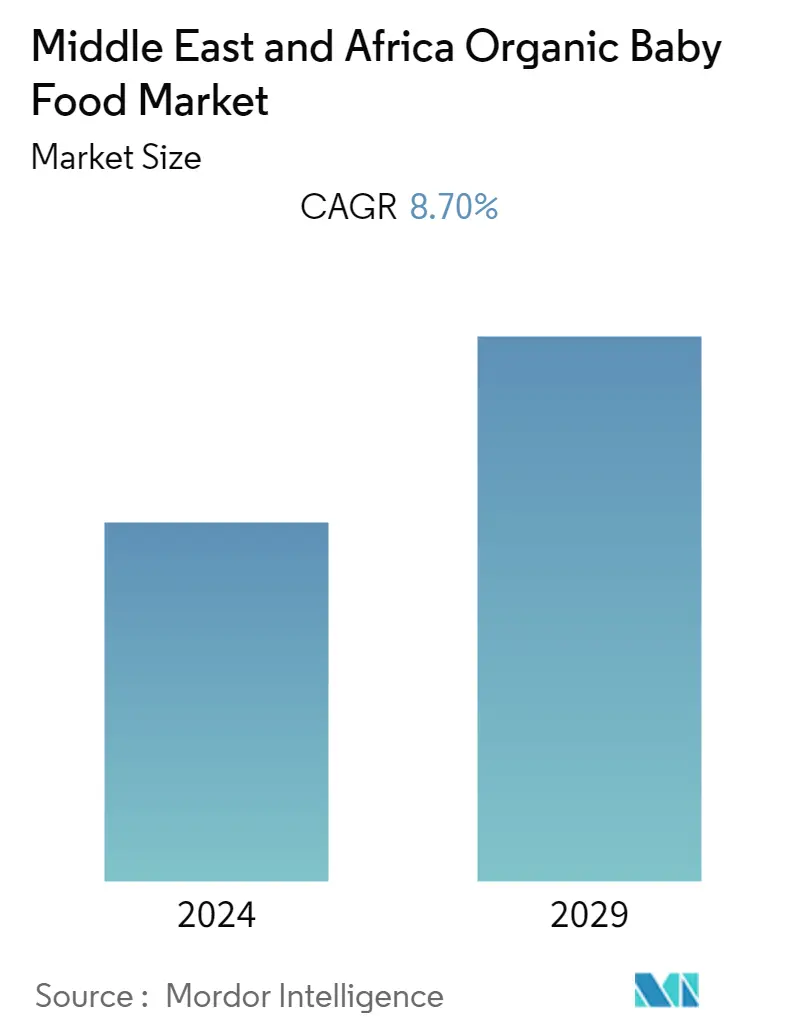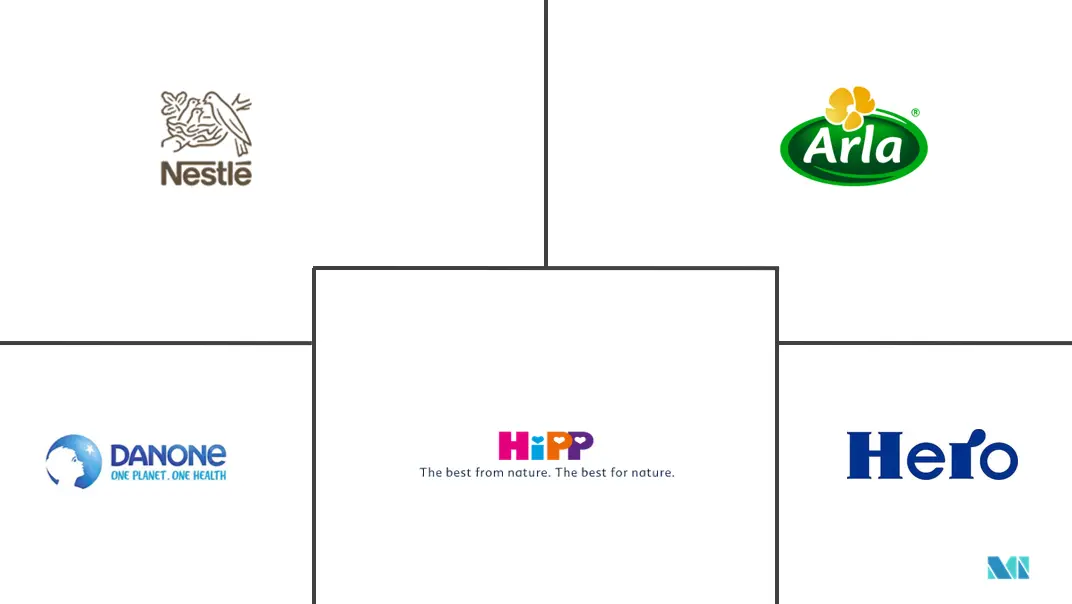Market Size of Middle East & Africa Organic Baby Food Industry

| Study Period | 2019 - 2029 |
| Base Year For Estimation | 2023 |
| Forecast Data Period | 2024 - 2029 |
| Historical Data Period | 2019 - 2022 |
| CAGR | 8.70 % |
| Market Concentration | Low |
Major Players
*Disclaimer: Major Players sorted in no particular order |
MEA Organic Baby Food Market Analysis
The Middle East & Africa Organic Baby Food market is projected to register a CAGR of 8.7% during the forecast period, 2022-2027.
The COVID-19 pandemic has put food safety, health benefits, and hygiene at the forefront of consumers' minds. Parents are inclined toward organic baby foods as they have a notion that organic products are safe and devoid of pesticides and other chemicals. Further, the presence of immunity-boosting ingredients such as vitamins C and E and selenium increases the appeal of these products to concerned parents.
Modernization of parenting due to the changing lifestyles and busy work schedules are driving the demand for packaged baby food which offers convenience over home-cooked food preparation. Additionally, consumers are aware of the ingredients used in processed baby food products and are increasingly interested in the clean label claims, which in turn accelerates the sales of organic baby food. The trend is particularly apparent in the Middle East region, driven by growth in the urban population, rising incomes, and a marked increase in the working women population.
Moreover, in response to the shift in consumer preferences, manufacturers are focusing on the introduction of new organic products with innovative flavors. For instance, according to Tetrapak, 27% of all baby milk and food launched in the Middle East in the year 2020 featured an organic claim, a 12% increase from 2019 indicating the growth of the market in the region.
MEA Organic Baby Food Industry Segmentation
Organic baby foods are manufactured by using ingredients that are grown or processed without synthetic fertilizers or pesticides. The Middle East & Africa organic baby food market is segmented by product type, distribution channel, and geography. By product type, the segmentation includes milk formula, prepared baby food, dried baby food, and others. By distribution channel, the market is segmented into supermarkets/hypermarkets, convenience stores, online retail stores, and other distribution channels. It provides an analysis of emerging and established economies in Middle East & Africa including the United Arab Emirates, Saudi Arabia, South Africa, and the Rest of Middle East & Africa). For each segment, the market sizing and forecasts have been done on the basis of the value (in USD million).
| By Product Type | |
| Milk Formula | |
| Prepared Baby Food | |
| Dried Baby Food | |
| Others |
| By Distribution Channel | |
| Supermarkets/Hypermarkets | |
| Convenience Stores | |
| Online Stores | |
| Other Distribution Channels |
| By Geography | |
| Saudi Arabia | |
| South Africa | |
| Rest of Middle East and Africa |
Middle East & Africa Organic Baby Food Market Size Summary
The Middle East & Africa Organic Baby Food market is experiencing significant growth, driven by increasing consumer awareness of food safety, health benefits, and hygiene, particularly in the wake of the COVID-19 pandemic. Parents are increasingly opting for organic baby foods, believing them to be safer and free from harmful chemicals, which is further enhanced by the inclusion of immunity-boosting ingredients. The modernization of parenting, characterized by busy lifestyles and the need for convenience, is propelling the demand for packaged baby food. This trend is particularly pronounced in urban areas of the Middle East, where rising incomes and a growing number of working women are contributing to the market's expansion. Consumers are also showing a keen interest in clean label claims, which is boosting the sales of organic baby food products.
Manufacturers are responding to these changing consumer preferences by introducing new organic products with innovative flavors and fortifying them with essential nutrients to support children's growth and development. The market is characterized by a fragmented landscape with key players such as Nestle SA, Danone SA, and Arla Foods Group actively expanding their presence and product offerings in the region. The increasing number of working mothers, who prefer ready-to-eat and instant formulas due to time constraints, is further driving market growth. Additionally, the emergence of specialized online delivery platforms is facilitating convenient access to a wide range of organic baby food products, catering to the diverse preferences of parents in the region.
Middle East & Africa Organic Baby Food Market Size - Table of Contents
-
1. MARKET DYNAMICS
-
1.1 Market Drivers
-
1.2 Market Restraints
-
1.3 Porter's Five Force Analysis
-
1.3.1 Threat of New Entrants
-
1.3.2 Bargaining Power of Buyers/Consumers
-
1.3.3 Bargaining Power of Suppliers
-
1.3.4 Threat of Substitute Products
-
1.3.5 Intensity of Competitive Rivalry
-
-
-
2. MARKET SEGMENTATION
-
2.1 By Product Type
-
2.1.1 Milk Formula
-
2.1.2 Prepared Baby Food
-
2.1.3 Dried Baby Food
-
2.1.4 Others
-
-
2.2 By Distribution Channel
-
2.2.1 Supermarkets/Hypermarkets
-
2.2.2 Convenience Stores
-
2.2.3 Online Stores
-
2.2.4 Other Distribution Channels
-
-
2.3 By Geography
-
2.3.1 Saudi Arabia
-
2.3.2 South Africa
-
2.3.3 Rest of Middle East and Africa
-
-
Middle East & Africa Organic Baby Food Market Size FAQs
What is the current Middle East & Africa Organic Baby Food Market size?
The Middle East & Africa Organic Baby Food Market is projected to register a CAGR of 8.70% during the forecast period (2024-2029)
Who are the key players in Middle East & Africa Organic Baby Food Market?
Nestle SA, Hero Group, Arla Foods Group, Danone SA and Hipp Gmbh & Co. are the major companies operating in the Middle East & Africa Organic Baby Food Market.

